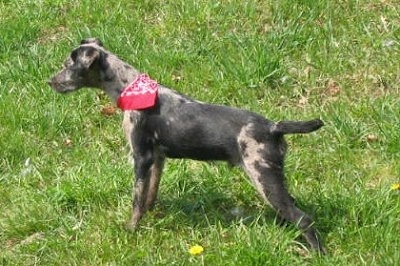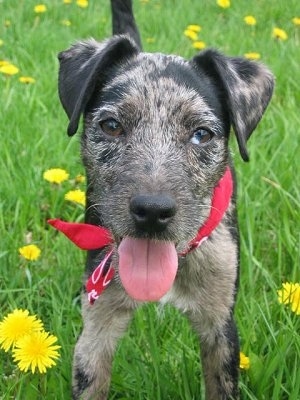
Autumnbriar I'm a Survivior AKA Rupert, a mini black merle Atlas, 12.5 inches, 12 lbs.
at-las ter-ri-er
The Atlas Terrier is an offshoot of the Jack Russell Terrier, one difference being it can be solid in color. While the Atlas Terrier can come in any color, including merles and brindles, it cannot have more that 15% of white, which will allow for a white collar, toes, facial blaze and chest. The Atlas Terrier comes in two coat varieties, smooth and wire. Tail docking is optional as well, but an undocked tail must curl completely over the back and must fall below the body topline. A docked tail must be carried high above the body topline. The skull is flat between the ears, then tapers. The stop is defined, but not abrupt. Eyes are almond-shaped and can be solid, marbled or cracked with any of the following colors: brown, amber, yellow, green, hazel, cobalt, glass. The V-shaped ears fold forward. The neck is strong, well set and of decent length. The body is tapered with a sleeve-like chest. The hind end is powerful, well angulated. The coat is a thick, loose-skinned and weather resistant, as without a good coat a terrier is very susceptible to the elements, above and below ground. The Atlas Terrier is a dog built for athleticism, speed and flexibility. A spannable and pliable chest is of utmost importance, any other will have difficulty functioning underground. They are highly motivated, extremely willing and incredibly intelligent.
Much like the Jack Russell, the Atlas Terrier is an outgoing, devilish, merry, devoted and loving dog. It is spirited and obedient, yet absolutely fearless. Careful and amusing, he enjoys games and playing with toys. An Atlas terrier will enjoy playing with your children as long as the playing stays "friendly" and the dog does not start to fear for its safety and/or see himself above the kids in the pecking order. They are extremely intelligent, and will enjoy trying to outsmart their owners at every turn; they will test the boundaries and push the limits, so owners need to be on their toes. Much to their delight, they will enjoy training their owners, but such can lead to tragic events if the owner cannot safely keep their little devil (oops! we mean angel) under control. This means staying the dog's calm, but firm, confident and consistent pack leader at all times. Do not allow this breed to take over your home or you will experience many behavior issues. Be careful not to treat them as if they were little humans. Learn canine instincts and treat them accordingly. The Atlas breed is less dominant than its Jack Russell cousin, but can get into tiffs with other dogs if they are challenged. Early socialization and an owner who displays natural authority can help suppress this behavior. They have a high prey drive and small, cute fuzzy critters will perk their interest. As the terrier mentally matures the hunting instinct will also grow, having potential victims as pets is best if they are kept separated. They like to chase and explore EVERYTHING, Be careful not to let them off the lead unless they are very well-trained. Atlas Terriers like to bark, dig and chew, especially if bored or ignored. Atlas Terriers climb, which means they can climb over a fence. They also jump. This is a BIG dog in a little dog’s body. The owner needs to be routine, firm, and half as smart (only kidding....), know the boundaries before the furball, so everybody will know what to correct it from doing and when to let it have at it. The RIGHT owner for an Atlas Terrier is capable of giving direction, knows how to set boundaries, and won't mind doing daily physical and mental exercise Problems will arise if an owner does not provide the proper amount of exercise and or leadership.
Height: Toy 9 - 11 inches (23 - 28 cm)
Weight: Toy 6 - 12 pounds 2.7 - 5.4 kg)
Height: Mini 11 - 13 inches (28 - 33 cm)
Weight: Mini 10 - 15 pounds (4.6 - 6.9 kg)
Height: Standard 13 - 15 inches (33 - 38 cm)
Weight: Standard 13 - 18 pounds (6 - 8 kg)
What makes the Atlas so special is the extreme controlled breeding program used to create this breed. All originating dogs used were health tested as much as modernly possible and they were monitored well into their senior years as longevity was a concern as well. To this day no major health problems have been detected.
The Atlas Terrier will do okay in an apartment if it is sufficiently exercised. They are very active indoors and will do best with at least an average-sized yard. If the Atlas Terrier is kept in an apartment, the dog should have a person home with it during the day unless the dog is crate trained. Even then, the owner better expect to get some exercise or be pestered to death for belly rubs and tug-of-war games when he/she gets home.
Like the Jack Russell, the Atlas Terrier will exercise and amuse itself in a yard, but without supervision its choice of activity may not be to your liking. They thrive on being your shotgun buddy and anywhere you go, they would like to be with you. They need to be taken on long daily walks. They excel in active sports, like agility, flyball and racing. We like to say that a tired Atlas is a well exercised owner.
About 15 or more years.
The Atlas Terrier comes in two coat varieties, smooth and wire. Neither are high-maintenance coats. Special grooming is not required on your wire coated dogs, unlike a Wire Fox Terrier, this coat is hard, and lays flat to the body. Routine brushing and combing and occasional bathing will keep them in good coat condition, and reduce shedding.
The Atlas Terrier is a byproduct of the Jack Russell Terrier. The JRT originated by crossing many terrier breeds together, the base breed being Fox Terrier and The Old English White Terrier (now extinct), but other solid-colored breeds such as Border Terrier, Lakelands and Manchester were crossed in as well. The Parson himself kept an ole black and tan stud in his kennel. In the day of the Parson, many dogs used for breeding where based solely on their working ability; color and conformation were often given little consideration.
In our modern day society, very few dogs are used for the original task they were bred for, and breeding for LOOKS became the primary importance, with the standard for the JRT being a mostly solid white-colored dog, dogs born of solid or excessive coloring where either culled at birth or given away as non-breedable dogs.
The gene that causes the predominant white coloration does have its price, and like other spotted white dog breeds, the JRT has become affected with deafness. It was out of this concern that the Atlas Terrier was born, as its solid coloration greatly reduces the chance of deafness.
The ATA (Atlas Terrier Association) is the most unique in the world, as all Atlas Terriers are DNA profiled and microchipped.

Autumnbriar I'm a Survivior AKA Rupert, a mini black merle Atlas, 12.5 inches, 12 lbs.

Autumnbriar I'm a Survivior AKA Rupert, a mini black merle Atlas, 12.5 inches, 12 lbs.